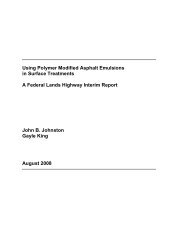Handbook for Bridge Inspections - TSP2
Handbook for Bridge Inspections - TSP2
Handbook for Bridge Inspections - TSP2
You also want an ePaper? Increase the reach of your titles
YUMPU automatically turns print PDFs into web optimized ePapers that Google loves.
t I e<br />
---::--._.- . -.<br />
._'_.. !<br />
Figure 7.1-10: V(lrimioll ill Chloride COl1lel1l OfCO/III11I1S accQrding 10 Height<br />
above Sea-/e~·e1-Gil/lsoystraulllen <strong>Bridge</strong><br />
3. Geometric Effects: Exposure is greater on large cross-sections<br />
and badly geometrically shaped cross-sections - see Figure 7.3-<br />
18.<br />
In addition, local circumstances can exist related to the terrain<br />
around the bridge or to the sea bed around the columns and which<br />
can also affect chloride impact (skerries and foundations produce a<br />
lot of spray).<br />
All of these factors produce simultaneous effects and a joint chloride<br />
impact pattern.<br />
The following contains a rough overview of those sub and superstructural<br />
surfaces most and least exposed to chlorides.<br />
Surfaces most exposed<br />
to Chloride Penetration<br />
Surfaces least exposed<br />
to Ch loride Penetration<br />
Substructure<br />
Large cross-sections of the leeward side of columns between 0 and<br />
20 metres above the surface oflhc water, e.g. the ma in columns of<br />
cantilever bridges; also the underneath of top cross-beams near the<br />
surface of the water.<br />
The windward sides of thin columns with a high elevation above<br />
sea-level.
















